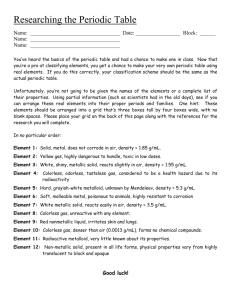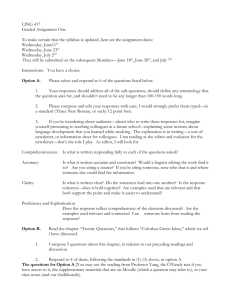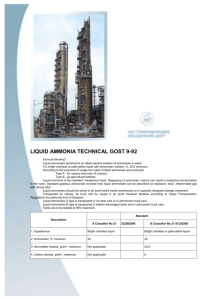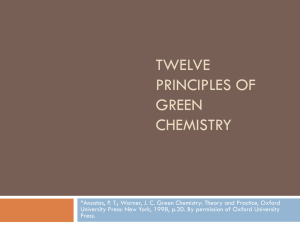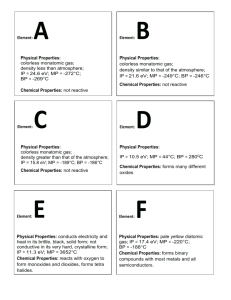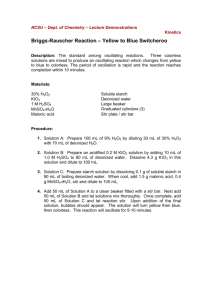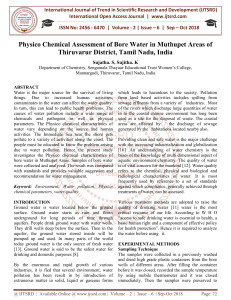Recognizing Chemical Reactions
advertisement
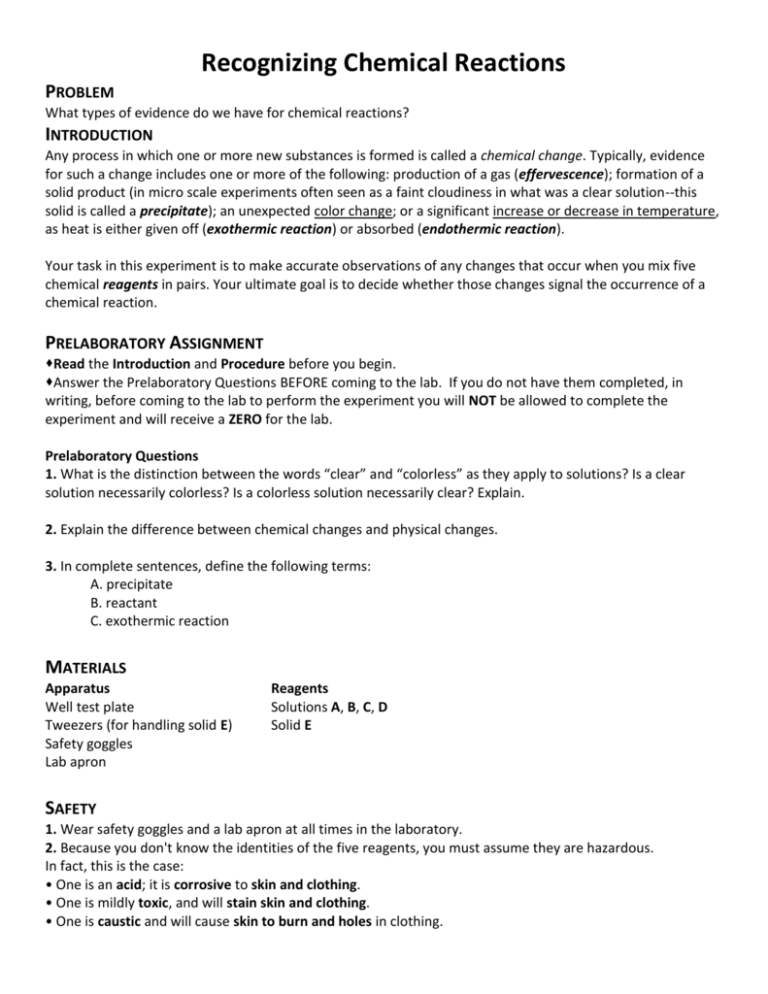
Recognizing Chemical Reactions PROBLEM What types of evidence do we have for chemical reactions? INTRODUCTION Any process in which one or more new substances is formed is called a chemical change. Typically, evidence for such a change includes one or more of the following: production of a gas (effervescence); formation of a solid product (in micro scale experiments often seen as a faint cloudiness in what was a clear solution--this solid is called a precipitate); an unexpected color change; or a significant increase or decrease in temperature, as heat is either given off (exothermic reaction) or absorbed (endothermic reaction). Your task in this experiment is to make accurate observations of any changes that occur when you mix five chemical reagents in pairs. Your ultimate goal is to decide whether those changes signal the occurrence of a chemical reaction. PRELABORATORY ASSIGNMENT Read the Introduction and Procedure before you begin. Answer the Prelaboratory Questions BEFORE coming to the lab. If you do not have them completed, in writing, before coming to the lab to perform the experiment you will NOT be allowed to complete the experiment and will receive a ZERO for the lab. Prelaboratory Questions 1. What is the distinction between the words “clear” and “colorless” as they apply to solutions? Is a clear solution necessarily colorless? Is a colorless solution necessarily clear? Explain. 2. Explain the difference between chemical changes and physical changes. 3. In complete sentences, define the following terms: A. precipitate B. reactant C. exothermic reaction MATERIALS Apparatus Well test plate Tweezers (for handling solid E) Safety goggles Lab apron Reagents Solutions A, B, C, D Solid E SAFETY 1. Wear safety goggles and a lab apron at all times in the laboratory. 2. Because you don't know the identities of the five reagents, you must assume they are hazardous. In fact, this is the case: • One is an acid; it is corrosive to skin and clothing. • One is mildly toxic, and will stain skin and clothing. • One is caustic and will cause skin to burn and holes in clothing. PROCEDURE 1. At your workstation there is a set of four thin-stem pipettes, each containing one of the solutions, A-D. There is also find a small container of solid E. Make observations of these substances and record your observations in a Data Table. 2. Mix three drops of solution A with three drops of solution B in one well of your well test plate. Continue in this fashion until you have tested all possible pairs of solutions, recording your observations in a Data Table with the headings: Substances mixed, Observations, Reaction? and Interpretation. (Because you are concerned with possible reactions between pairs of reactants, you should not mix three or more together at one time.) 3. Not all reactions are rapid. If no change is evident at first, observe again after about 4 minutes to see if gradual changes have taken place. To detect any temperature changes, place your fingertip on the underside of each well before and after mixing. 4. Next, use tweezers to select individual pieces of E, placing one piece in each of four wells in your test plate. Add 8-10 drops of a different solution to each piece of E. Record your observations in your Data Table. 5. When you have completed steps 1-4, compare your results with those of other groups in class the next day. If you think further tests are called for, complete those tests before cleaning up and returning to the classroom for the post-lab discussion. CLEANING UP 1. Use your wash bottle to rinse all liquids into the waste container which has been lined with paper towels. 2. Wash the test plate with soap and water, rinse with tap water and set on paper towels to dry. Make sure that no solid materials go into the sink. 3. Wash your hands thoroughly before leaving the laboratory. ANALYSIS AND CONCLUSIONS Complete the Analysis and Conclusions section for this experiment either on your Report Sheet or in your lab report as directed by your teacher. 1. How did your results compare with those of other groups? Suggest possible explanations for any significant differences that you observed. Name Partner Period Recognizing Chemical Reactions PRE-LABORATORY QUESTIONS 1. What is the distinction between the words “clear” and “colorless” as they apply to solutions? Is a clear solution necessarily colorless? (Answer in a complete sentence). Is a colorless solution necessarily clear? (Answer in a complete sentence) Explain. Clear: Colorless: 2. Explain the difference between chemical changes and physical changes. Chemical Change: Physical Change: 3. In complete sentences, define the following terms: A. precipitateB. reactantC. exothermic reaction- Name Partner Period Recognizing Chemical Reactions PROCEDURAL DIAGRAMS Figure 1: Unknowns Tray Figure 2: Well-Plate Set-Up DATA/OBSERVATIONS Table 1: The Reactants – Set # _____ Substance A B C D E Phys. State Solid Table 2: The Reactions – Set # _____ Description Substances Observations Reaction? Interpretation (What YOU saw) (Yes/No) (On what did you base your choice?) A+B A+C A+D A+E B+C B+D B+E C+D C+E D+E ANALYSIS AND CONCLUSIONS How did your results compare with those of other groups? In what ways were your results similar or different? Suggest possible explanations for any significant differences that you observed.


